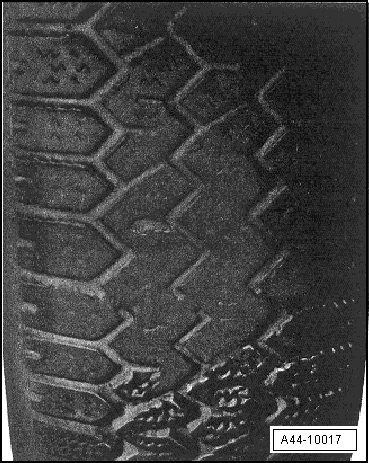Volkswagen Polo Service & Repair Manual: Wear Spots
| Wear spots are caused by a hard stop with locked wheels
whereby the rubber compound is abraded from the contact patch. |
| When the tires slide across the road surface, frictional
heat is generated which reduces the abrasion resistance on the
tread compound. |
| Even the most abrasion-resistant tread compound cannot
prevent wear spots which can occur during extreme braking. |
| Even ABS cannot completely prevent brief locking and the
resulting slightly flat spots. |
| The degree of abrasion is primarily dependent on the vehicle
speed, road surface and tire load. For clarification see the
following examples. |
| If a vehicle with locked front wheels is decelerated until
it comes to a stop, the abrasion of rubber on the post card
sized contact patch is approximately |
| from 57 km/h (35.41 mph) = 23.8 m braking distance, up to
2.0 mm, |
| from 75 km/h (46.60 mph) = 41.8 m braking distance, up to
3.3 mm, |
| from 92 km/h (57.16 mph) = 71.6 m braking distance, up to
4.8 mm. |
|
|
|
| Tires with this type of damage cannot be used and must be
replaced. |
|
|

|
Rolling noise perceived by the human ear is caused by
vibrations transmitted from the noise source to the ear via the
air.
Here we are interest ...
Other materials:
Switching the front passenger front airbag on and off manually using the key-operated
switch
Fig. 58 In the stowage compartment on
the front passenger side: key switch for disabling and enabling the front airbag
on the front passenger side
First read and observe the introductory information
and safety warnings
The front passenger front airbag must be switched off when securing a
...
Unlocking the tailgate manually
Fig. 158 In the luggage
compartment: manual release for the tailgate
First read and observe the introductory
information and safety warnings
If necessary, fold the backrest of the rear bench seat forwards .
Remove items of luggage so that you can reach the tailgate from the
insid ...
Increasing Temperature Due To Low Tire Pressure
The diagram shows the temperature behavior of a tire at
speed of 180 km/h (111.84 mph).
A -
Normal range: when maintaining the specified tire pressure,
the temperature remains stable.
B -
...
© 2016-2025 Copyright www.vwpolo.net

 Tires, Rolling Noises, General Information
Tires, Rolling Noises, General Information

